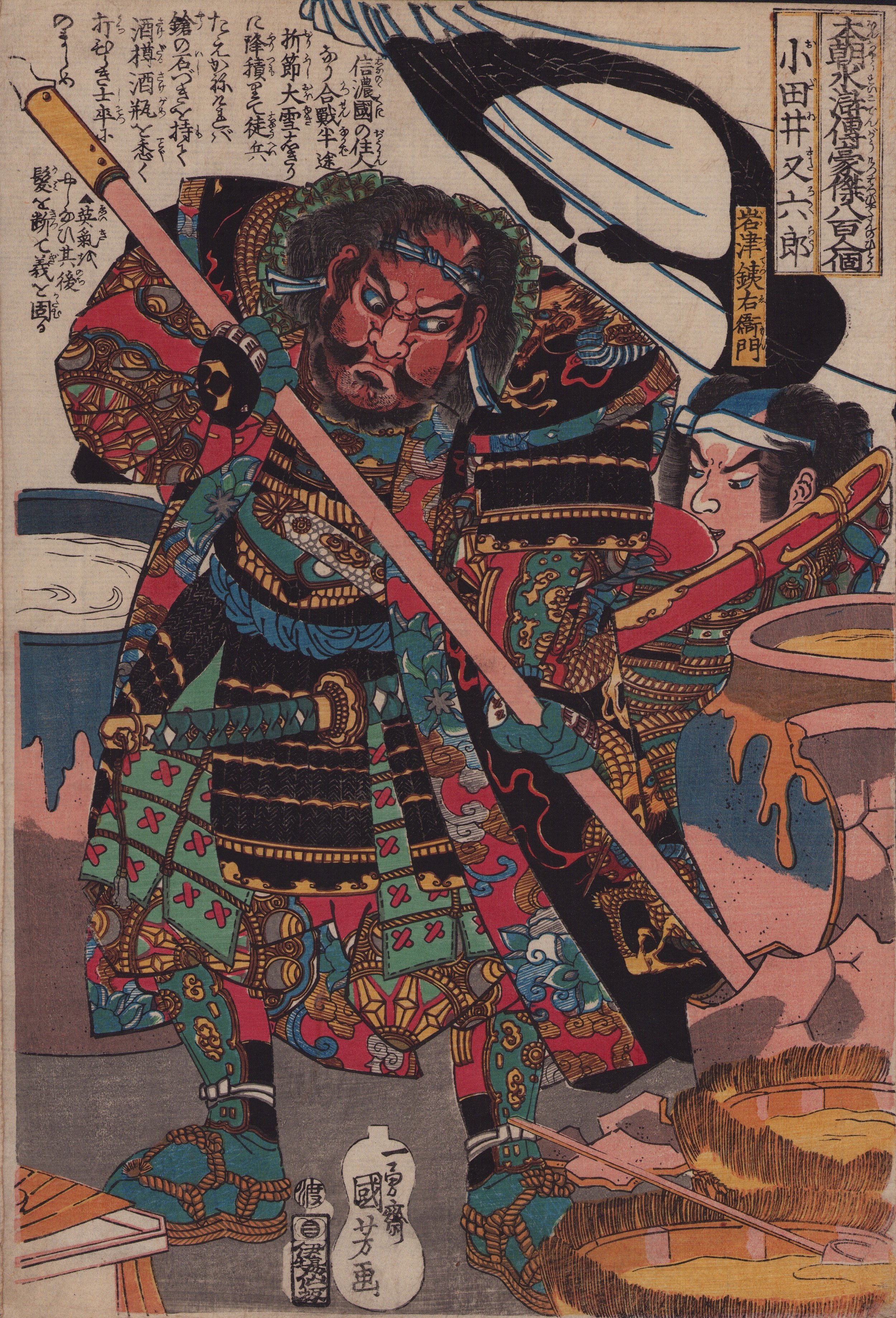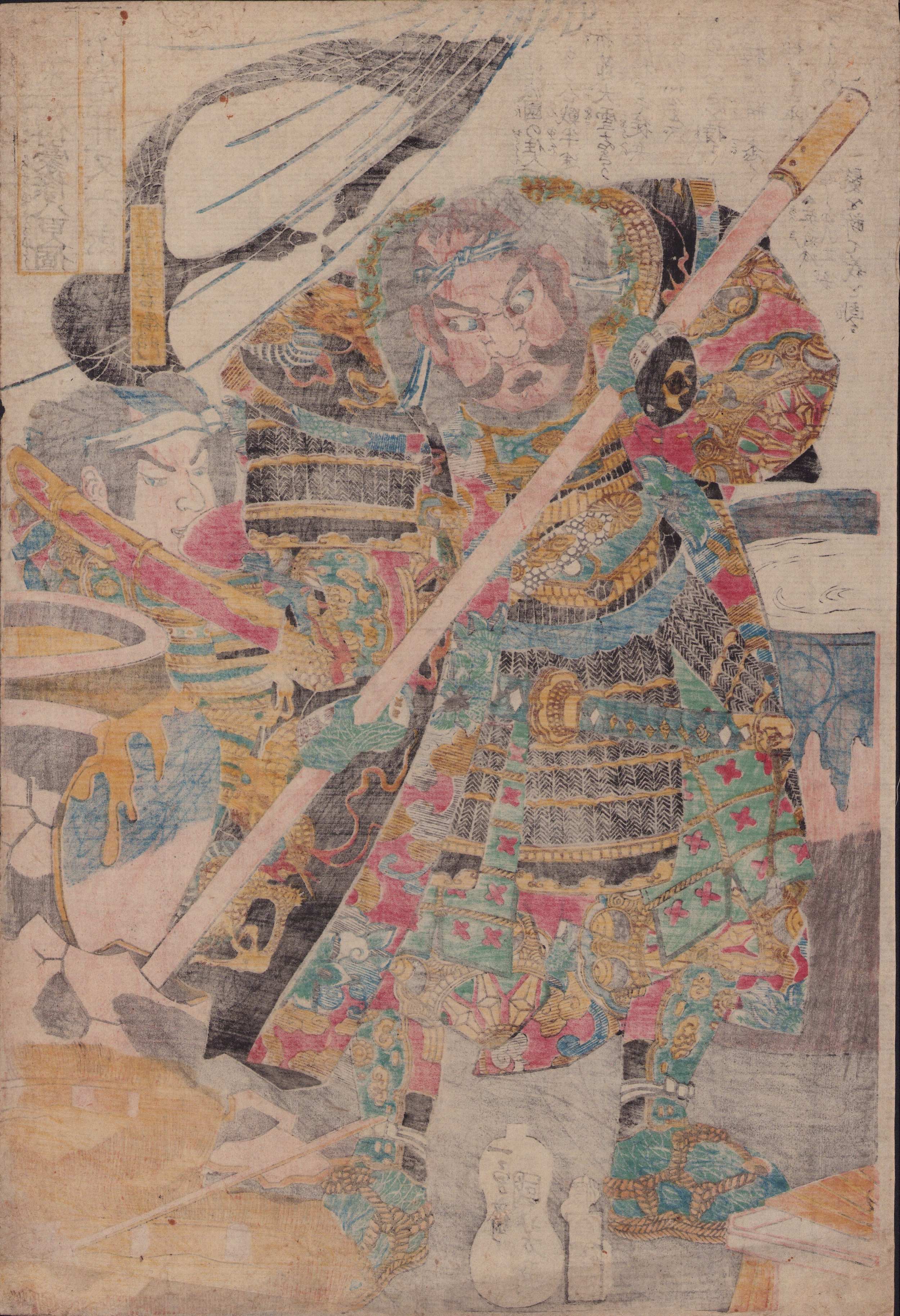Kuniyoshi | Odai Matarokuro, 800 Heroes of Japanese Suiko-den
歌川国芳 Utagawa Kuniyoshi (1798–1861)
本朝水浒传 小田井又六郎
Odai Matarokuro, from the series of 800 Heroes of Japanese Suiko-den
1818–1829
木版画 | 纵绘大判 | 37cm x 25cm
Woodblock-print | Oban tata-e | 37cm x 25cm
轻微褐变;少许虫洞经修复
Slight browning; restored small wormholes
$3,800
“项羽乃悉引兵渡河,皆沉船,破釜甑…”——《史记 项羽本纪》
破釜沉舟,是我们从小就耳熟能详的历史典故。楚霸王项羽以其决绝的意志,以少胜多,最终大败秦军,赢得了战争。而在日本,也有一个与之类似的传奇故事——“破瓶突围”,本幅浮世绘也正是取材于此。
画中的主角名为小田井又六郎,是历史上存在过的真实人物,为十六世纪初信浓国小田井城的城主。但实际上,“破瓶突围”发生在另一位战国人物——柴田胜家(1522-1583)身上,与小田井并无关系。这种历史故事与传奇的错乱附会,在江户时期的文艺作品中屡见不鲜。
柴田胜家,战国时代赫赫有名的猛将,是织田家“四天王”之一。而使他扬名天下的,就是这场“破瓶突围”之战。1570年,柴田胜家负责镇守织田信长在近江的一座城池。而他面对的敌人,是实力强大的大名六角义贤。人马众多的六角军为了能迅速击溃胜家,直接截断了供给城中的水源。对于这座草草建成的小城池,断水就意味着灭亡。面对如此困境,孤注一掷的胜家果断地让士兵们喝饱了水,之后便用刀枪戳破水壶,砸烂水缸,抱着不战死便渴死的必胜决心,于晚间从敌军防守薄弱处成功突围,并最终以极少的兵力大破敌军,获得全胜。从此,“破瓶柴田”的名号传遍了全日本;同时,由于其冲锋杀敌时的模样十分恐怖,好似恶鬼降世,众人还为他安上了一个“鬼柴田”的头衔。
从画中液体的颜色,散落的酒勺,以及岩津铁右卫门手中的红漆清酒杯来看,小田井打破的其实是酒缸。透过国芳极具张力的笔触,我们的鼻腔也仿佛被一股浓烈的酒气所充盈。“有志者,事竟成,破釜沉舟,百二秦关终属楚。”置之死地而后生,背水一战,向来都是专属于铁血英雄的浪漫。
Interested in purchasing?
Please contact us.
歌川国芳 Utagawa Kuniyoshi (1798–1861)
本朝水浒传 小田井又六郎
Odai Matarokuro, from the series of 800 Heroes of Japanese Suiko-den
1818–1829
木版画 | 纵绘大判 | 37cm x 25cm
Woodblock-print | Oban tata-e | 37cm x 25cm
轻微褐变;少许虫洞经修复
Slight browning; restored small wormholes
$3,800
“项羽乃悉引兵渡河,皆沉船,破釜甑…”——《史记 项羽本纪》
破釜沉舟,是我们从小就耳熟能详的历史典故。楚霸王项羽以其决绝的意志,以少胜多,最终大败秦军,赢得了战争。而在日本,也有一个与之类似的传奇故事——“破瓶突围”,本幅浮世绘也正是取材于此。
画中的主角名为小田井又六郎,是历史上存在过的真实人物,为十六世纪初信浓国小田井城的城主。但实际上,“破瓶突围”发生在另一位战国人物——柴田胜家(1522-1583)身上,与小田井并无关系。这种历史故事与传奇的错乱附会,在江户时期的文艺作品中屡见不鲜。
柴田胜家,战国时代赫赫有名的猛将,是织田家“四天王”之一。而使他扬名天下的,就是这场“破瓶突围”之战。1570年,柴田胜家负责镇守织田信长在近江的一座城池。而他面对的敌人,是实力强大的大名六角义贤。人马众多的六角军为了能迅速击溃胜家,直接截断了供给城中的水源。对于这座草草建成的小城池,断水就意味着灭亡。面对如此困境,孤注一掷的胜家果断地让士兵们喝饱了水,之后便用刀枪戳破水壶,砸烂水缸,抱着不战死便渴死的必胜决心,于晚间从敌军防守薄弱处成功突围,并最终以极少的兵力大破敌军,获得全胜。从此,“破瓶柴田”的名号传遍了全日本;同时,由于其冲锋杀敌时的模样十分恐怖,好似恶鬼降世,众人还为他安上了一个“鬼柴田”的头衔。
从画中液体的颜色,散落的酒勺,以及岩津铁右卫门手中的红漆清酒杯来看,小田井打破的其实是酒缸。透过国芳极具张力的笔触,我们的鼻腔也仿佛被一股浓烈的酒气所充盈。“有志者,事竟成,破釜沉舟,百二秦关终属楚。”置之死地而后生,背水一战,向来都是专属于铁血英雄的浪漫。
Interested in purchasing?
Please contact us.
歌川国芳 Utagawa Kuniyoshi (1798–1861)
本朝水浒传 小田井又六郎
Odai Matarokuro, from the series of 800 Heroes of Japanese Suiko-den
1818–1829
木版画 | 纵绘大判 | 37cm x 25cm
Woodblock-print | Oban tata-e | 37cm x 25cm
轻微褐变;少许虫洞经修复
Slight browning; restored small wormholes
$3,800
“项羽乃悉引兵渡河,皆沉船,破釜甑…”——《史记 项羽本纪》
破釜沉舟,是我们从小就耳熟能详的历史典故。楚霸王项羽以其决绝的意志,以少胜多,最终大败秦军,赢得了战争。而在日本,也有一个与之类似的传奇故事——“破瓶突围”,本幅浮世绘也正是取材于此。
画中的主角名为小田井又六郎,是历史上存在过的真实人物,为十六世纪初信浓国小田井城的城主。但实际上,“破瓶突围”发生在另一位战国人物——柴田胜家(1522-1583)身上,与小田井并无关系。这种历史故事与传奇的错乱附会,在江户时期的文艺作品中屡见不鲜。
柴田胜家,战国时代赫赫有名的猛将,是织田家“四天王”之一。而使他扬名天下的,就是这场“破瓶突围”之战。1570年,柴田胜家负责镇守织田信长在近江的一座城池。而他面对的敌人,是实力强大的大名六角义贤。人马众多的六角军为了能迅速击溃胜家,直接截断了供给城中的水源。对于这座草草建成的小城池,断水就意味着灭亡。面对如此困境,孤注一掷的胜家果断地让士兵们喝饱了水,之后便用刀枪戳破水壶,砸烂水缸,抱着不战死便渴死的必胜决心,于晚间从敌军防守薄弱处成功突围,并最终以极少的兵力大破敌军,获得全胜。从此,“破瓶柴田”的名号传遍了全日本;同时,由于其冲锋杀敌时的模样十分恐怖,好似恶鬼降世,众人还为他安上了一个“鬼柴田”的头衔。
从画中液体的颜色,散落的酒勺,以及岩津铁右卫门手中的红漆清酒杯来看,小田井打破的其实是酒缸。透过国芳极具张力的笔触,我们的鼻腔也仿佛被一股浓烈的酒气所充盈。“有志者,事竟成,破釜沉舟,百二秦关终属楚。”置之死地而后生,背水一战,向来都是专属于铁血英雄的浪漫。
Interested in purchasing?
Please contact us.
Utagawa Kuniyoshi (1798–1861)
Warriors, ghosts, crabs and cats.
The woodblock print designs of Utagawa Kuniyoshi, one of Ukiyo-e’s most vibrant and creative 19th Century masters, encompass more than that – he depicted landscapes and beautiful women, too – but those are the first genres that come to mind when contemplating this wonderful and eccentric genius and his sprawling, timeless body of work.
From an early age, the young Kuniyoshi was fascinated by drama and history – with a big helping of the supernatural. He loved nature and animals, too – especially cats: again and again they pop up in designs throughout his career (adding a premium to the prices those woodblock prints fetch today). Starting out as a relatively traditional student of the Utagawa school, he soon developed his hugely energetic style, full of dynamic action, and eventually passed it on to his many students – Yoshitoshi being the most famous. Along with Kunisada and Hiroshige, he was among the most prolific of all Ukiyo-e artists.
He was born Yoshisaburō on January 1, 1798 to a silk dyer. Some say his father’s rich patterns influenced his bold, colorful designs. He always loved legends and history. By age 12 he had shown a talent for drawing and become a student of the great Toyokuni, who gave him the name Kuniyoshi. He also studied the Tosa, Kano and Maruyama painting styles.
It took awhile for him to find his place in the thriving Ukiyo-e world. Then in the 1820s he produced his first epic warrior triptychs, and his career success was assured. He often gave legendary heroes fanciful and intricate tattoos of his own design, starting a style craze in Edo.
He eventually expanded genres to include animal studies and landscapes. His wonderful oban yoko-e series of “Famous Views of the Eastern Capital” is especially interesting for its use of Western motifs, such as shadows, billowing clouds and a low vantage point to create atmospheric perspective. While these efforts weren’t always entirely successful, they still resulted in wonderfully lively Ukiyo-e designs.
In all, he produced nearly 250 series for 150 publishers.
During the Tempo reforms of the 1840s, which dramatically censured woodblock prints, he boldly skirted rules barring depictions of actors by putting their faces on various animals, such as turtles.
He died at the age of 63 in April 1861 in his home in Genyadana.
Partial citation: Marks, Andreas, Japanese Woodblock Prints, Artists, Publishers and Masterworks: 1680-1900 (Tuttle; 2010)


